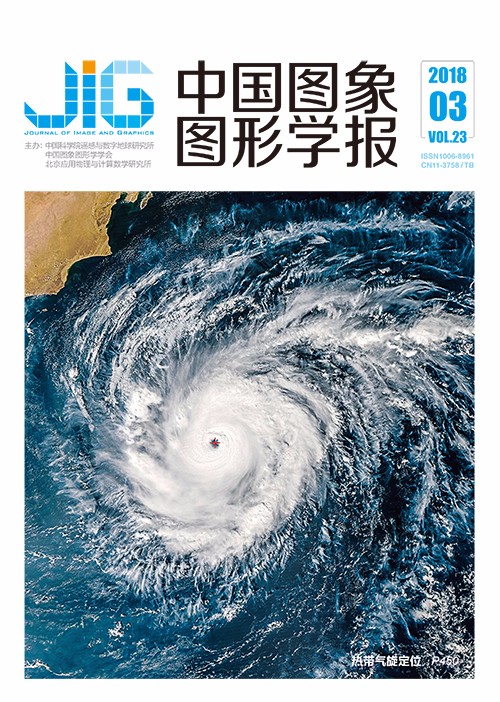
遮挡表情变化下的联合辅助字典学习与低秩分解人脸识别
摘 要
目的 从真实环境中采集到的人脸图片通常伴随遮挡、光照和表情变化等因素,对识别结果产生干扰。在许多特殊环境下,训练样本的采集数量也无法得到保证,容易产生训练样本远小于测试样本的不利条件。基于以上情况,如何排除复杂的环境变化和较少的训练样本等多重因素对识别效果的影响逐渐成为了人脸识别方向需要攻克的难题。方法 以低秩矩阵分解为基础,分别使用非凸秩近似范数和核范数进行两次低秩矩阵分解,以达到去除遮挡干扰的目的 。首先通过非凸稳健主成分分析分解得到去除了光照、遮挡等变化的低秩字典。为消除不同人脸类的五官等共通部分的影响,加快算法收敛效率,将得到的低秩字典用作初始化,进行基于核范数的第二次秩近似分解,以获得去除了类间不相关判别性的低秩字典用于分类。最后针对训练样本较少和遮挡样本占比过大等问题,选用同一数据库中不用做训练和测试的辅助数据作为辅助字典模拟可能出现的遮挡、光照等影响,通过最小化稀疏表示重构误差进行分类识别。结果 选用AR库和CK+库分别进行实验。在AR库的实验中,通过调整训练图片中遮挡、光照和表情变化的样本比例来检测算法性能。其中,在遮挡图片占比分别为1/7和3/7的训练集中,无遮挡图片由无干扰和光照表情干扰图片联合组成。在遮挡图片占比为2/7的训练集中,无遮挡图片全由光照表情变化图片组成。实验结果表明,在多种实验情况下均获得较高识别率。其中根据不同遮挡比例,分别获得97.75%、92%、95.25%和97.75%、90%、95.25%等识别率。与同类算法对比提高3%~5%。选用的外部数据从10类人脸至40类依次增加,获得的识别结果为96.75%~98%,与同类算法相比提高了2%~3%。在CK+表情库中,选用同伦算法配合分类求解,获得的识别结果为95.25%。结论 本文提出了一种在克服复杂环境变化和训练样本不足两个方面具有高效性和鲁棒性的人脸识别算法,实验结果表明,本文算法在不同数据库中都具有高效性,未来的研究方向包括将算法应用于联立人脸和表情识别,模拟更为复杂的噪声状况,以期达到更为优异的结果。
关键词
Occlusion expression variation face recognition based on auxiliary dictionary and low rank decomposition
Fu Xiaofeng, Zhang Yu, Wu Jun(School of Computer Science and Technology, Zhejiang DianZi University, Hangzhou 310018, China) Abstract
Objective Face recognition has an important role in our daily life. Applications are increasingly using face recognition as a useful interactive function. Real-life environments often introduce complex effects on data collection. Thus, face recognition always encounters challenges from several variations and occlusions. Face images collected from the real-world environment are usually accompanied with factors, such as occlusion, illumination, and expression changes, that interfere with recognition results. The number of collected training samples cannot be guaranteed in many special circumstances. Sometimes, the number of training samples is much smaller than the number of test samples. This paper aims to address difficult face recognition problems, such as eliminating complex environmental changes, undersampled training sets, and other recognition factors. Method This paper proposes an efficient face recognition algorithm under occlusion and the expressed variable, which is based on low rank approximation decomposition and auxiliary dictionary learning. It utilizes non-convex rank approximation norm and nuclear norm to perform matrix decomposition twice. The algorithm efficiently eliminates gross sparse errors on occlusion and other factors. First, we obtain the initial low-rank dictionary without illumination and occluded variation based on the non-convex robust principal component analysis algorithm to increase the convergence efficiency of the algorithm. Second, we perform the second low-rank decomposition based on a nuclear norm to obtain discriminant and incoherent low-rank dictionary and eliminate the influence of common facial parts through different classes. Finally, we choose the auxiliary data from the same database as an auxiliary dictionary that can simulate possible interference to overcome the problem of insufficient training samples and the large number of occlusion samples. The testing samples can be classified by minimizing the reconstruction error. This study considered the variation of noise, occlusion, illumination, and expression in the natural environment. The proposed efficient algorithm extracts low-complexity components that correspond to facial attributes, which are mutually incoherent among different classes (e.g., identity and expression) from training data, even in the presence of gross sparse errors. The lack of training data, joint low-rank dictionary, and auxiliary dictionary is addressed, and the weighted reconstruction model is established to complete the classification. Result We test our algorithm with the AR and CK+ databases. Experiments on both databases show that the proposed algorithm can achieve outstanding recognition accuracy. We divided the experiments on the AR database into three different training scales. We choose different numbers of images occluded by a scarf or sunglasses with an occlusion percent of 20%-40%. The number of occluded images that contain a scarf or sunglasses increased from one to three, and the unoccluded images decreased from six to four. The training set on each person consists of seven images. With one or three occluded images in the training set, the uncovered images consist of natural images with no extra interface factors, such as expression and illumination. However, when the proportion of the covered images is two in seven, the other five uncovered images contain expression and illumination variables. Experimental results demonstrate that the proposed algorithm has a higher recognition rate in a variety of experimental cases. According to the cover types, such as scarves and sunglasses, the recognition rates are 97.75%, 92%, 95.25%, 97.75%, 90%, and 95.25%. Compared with the recognition accuracy of recent algorithms, such as sparse representation classification, robust principal component analysis (RPCA), and non-convex RPCA, the recognition accuracy of the proposed method improved by 3% to 5%. The recognition results are 96.75%-98% when the amount of selected external data increased from 10 to 40. The recognition rates of the proposed method's recognition rates are 2%-3% higher than those of the compared algorithms. Conclusion The algorithm proposed in this paper can overcome the complex environmental variation and insufficient training sample problems effectively and robustly. We obtained state-of-the-art performance after testing on different databases. This study attempts to deal with data with multiple occlusions. The proposed algorithm aims to adapt to complex interference factors and achieves high recognition accuracy. However, this algorithm does not effectively deal with joint expression and face recognition. Thus, further research is needed to understand figure joint expression and face recognition.
Keywords
|



 中国图象图形学报 │ 京ICP备05080539号-4 │ 本系统由
中国图象图形学报 │ 京ICP备05080539号-4 │ 本系统由